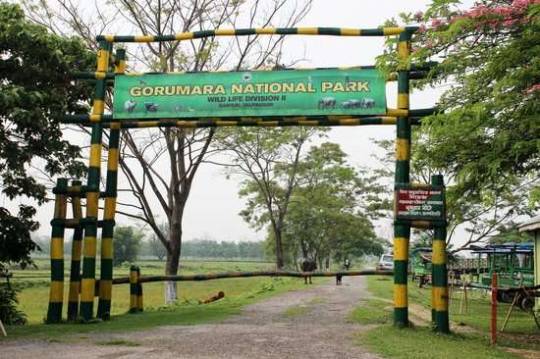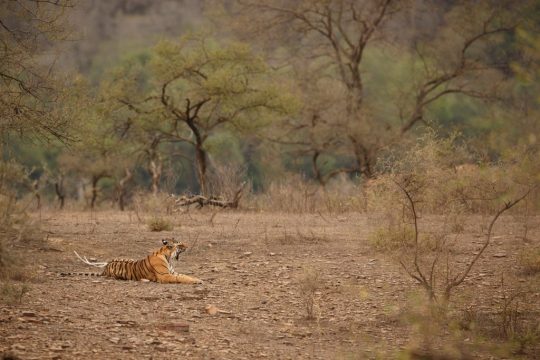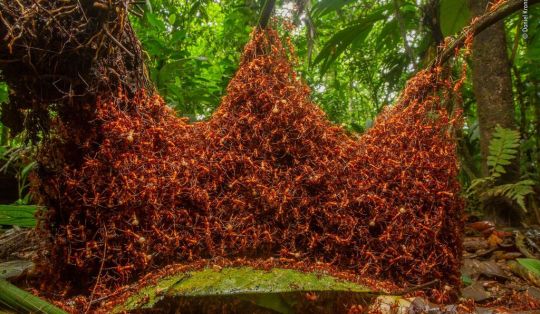#tiger population in buxa tiger reserve
Explore tagged Tumblr posts
Text
बक्सा टाइगर रिजर्व के बारे में रोचक तथ्य | Interesting Facts About Buxa Tiger Reserve In Hindi
बक्सा टाइगर रिजर्व के बारे में रोचक तथ्य | Interesting Facts About Buxa Tiger Reserve In Hindi बक्सा टाइगर रिजर्व, या बक्सा नेशनल पार्क पश्चिम बंगाल राज्य के उत्तर पूर्व जलपाईगुड़ी जिले के अलीपुरद्वार मंडल में स्थित है। Interesting Facts About Buxa Tiger Reserve: इस टाइगर रिजर्व की उत्तरी सीमा भूटान के साथ अंतरराष्ट्रीय सीमा साझा करता है। सींचुला पहाड़ी श्रृंखला बक्सा टाइगर रिजर्व के उत्तरी…

View On WordPress
#buxa tiger reserve definition in hindi#buxa tiger reserve in hindi#number of tigers in buxa tiger reserve#tiger population in buxa tiger reserve#tiger reserve in hindi#tiger reserve in india in hindi#where is buxa tiger reserve
0 notes
Text
How to Spend a Peaceful Weekend in Lataguri:

We all love to go for a trip on weekend days. The most common activity we can do is to explore nature and its biodiversity. When it comes to exploring nature then Lataguri is one of the most preferred places to visit. Located in the Jalpaiguri district of North Bengal, this is one of the preferred places to visit for those who want to explore the wildlife. The region is famous for its densely covered forest, and excellent sightseeing places.
If you are planning a weekend trip in Lataguri, then the first step you can do is to make a detailed plan for the trip. You can search for a Resort in Lataguri, for accommodation, the location you prefer and the facilities you want according to the budget. So if you are planning a peaceful weekend trip in Lataguri you can consider the following;
Itinerary for a two-day visit to Lataguri:
If you are planning for any kind of vacation then the first thing you should do is to prepare an itinerary. This helps you to create a budget and explore all the famous areas in a shorter amount of time. For instance, a two-day itinerary may include the following:
Day 1:
The first day of your journey begins with arriving in Lataguri and approaching your resort. But if you haven’t booked your resort yet and are looking for a good resort, you can search for a Luxury resort in Lataguri for the best facilities. After that get checked in, and manage your kinds of stuff and it’s time for you to get refreshed and consider having a light meal or snacks. Then you can explore the ambience of the resort and its surroundings. In the afternoon it’s time for you to visit the Gorumara National Park.
Gorumara National Park:
One of the first places you can visit in Lataguri is Gorumara National Park. The park covered with forest and green grasslands is one of the major tourist destinations. Here you can do various activities such as enjoying the jeep safari, bird watching activity and observing the wildlife. But since it’s a protected area you have to follow the guidelines issued by the forest authority.
Chapramari Wildlife Sanctuary:
After you are done exploring the Gorumara National Park, in the evening it’s time for you to explore the Chapramari Wildlife Sanctuary. This place is famous for its elephant population and if you want to enjoy the elephant ride then, this is the best place for you. You can also do other kinds of other activities such as visiting the watchtower, and here you can also observe the blooming of orchids.
Murti River:
After enjoying the beautiful wildlife sanctuaries, if you have some time you can visit the Murti River. Here you can have a picnic or relax on the river bank. There are also many forest bungalows near the river.
Foods:
If you are visiting Lataguri, then you should try the variety of foods available here. Some of the must-try foods are;
Momos: one of the most common fast food.
Bamboo shoot: a traditional tribal food in Lataguri, also considered as the staple food.
Sweets: Lataguri is known for its delicious variety of sweets such as Roshogolla and laddoo.
Fish curry: Bengal is famous for its fish curries and Lataguri situated in North Bengal cannot be an exception. Here you can taste different types of fish curry dishes. So with this, your first day in Lataguri ends.
Day 2:
On the second day, you can book a cab to explore the nearby regions of Jaldhaka and Buxa Tiger Reserve. So, it’s time to check out from your resort, book a cab and approach your next destination point.
Buxa Tiger reserve:
The Buxa Tiger Reserve located in the Alipurduar region of North Bengal is one of the ideal destination points for tourists. The region is home to a variety of wild animals such as tigers, elephants, Indian boar and various bird species are found here. Also, the Buxa fort is located here which is an important historical landmark.
Buxa Fort:
This is an ideal place to visit for tourists who are interested to know about the region’s history. You can do trekking and other kinds of activities making it one of the famous destination points.
Jaldhaka and its nearby exploration:
The next thing you can do is explore the major sightseeing areas of Jaldhaka such as Bindu, Paren and Jaldapara National Park. The reason why tourists are attracted towards this region is due to its natural valleys, village areas and cultural heritage. Jaldhaka, located near the Indo- Bhutan border is known for its beautiful nearby places and other activities such as trekking and hiking. Bindu is famous for the tourists who want to explore the cardamom plantations. So with this, your Jaldhaka exploration ends.
Exploring the local culture of Lataguri:
Lataguri is also famous for its diverse culture and population. This region is inhabited by many tribal communities such as Mech, Rajbanshi, Lepcha and other communities. The culture of this region includes tribal folk culture, songs, folk dance, and dramas. You can learn about their traditions, rituals and their way of life by interacting with them. You can also visit Lataguri during the festive season when the region is surrounded by joy and happiness. So with this, your two-day weekend trip in Lataguri comes to an end. You can return to your hotel and pack your things up so the next morning you can return.
Conclusion:
So, here we have discussed the itinerary for a day weekend trip to Lataguri. For accommodation and other facilities, you can consider checking all the available resorts in Lataguri. If you plan accordingly about your trip and book the resort in advance you may get some of the best facilities and reasonable rates. By doing this you can ensure your smooth and memorable journey.
0 notes
Text
Plan Your Perfect Escape: Top Dooars Tour Packages for Every Traveler

Sometimes a retreat from your daily life is crucial to regain the vibrant colour of life. Dooars tour packages is your solution. Dooars is a captivating area in the Himalayan foothills. The place is popular as a holiday destination for its serene beauty. The dense greenery and wildlife are the highlight of this place.
Any thrill-seeking soul will enjoy the beauty of nature along with the close encounter with rare species. It is home to different sanctuaries including Buxa Tiger Reserve, Gorumara National Park, Jaldapara Wildlife Sanctuary, and Chapramari Wildlife Sanctuary. The place is worth visiting. Book your well-planned package to Dooars and fall in love with its beauty.
Top Dooars packages includes:
2 Nights In Jaldapara
Duration: 02 Nights/03 Days
Highlights: Spotting different wildlife, Birdwatching, Elephant Safari, Sightseeing, Strolling in Meadows
This package offers a fun exploration of Jaldapara National Park. The place is known for its population of one-horned rhinoceros, Bengal tigers, barking deer, wild pigs, turtles, hog deer, etc. The journey of Jaldapara will start with the welcoming of beautiful elephant grass and several animals grazing. You can watch them passing by. To get to see these creatures, an elephant safari will be organized, where you can have close encounters with the creatures. The thrilling feeling all day long can make you tired. Back to your resort, have drinks and traditional meals. Don't forget to buy souvenirs.
Jaldapara - Lataguri, Beautiful Dooars
Duration: 03 Nights/04 Days
Highlights: Spotting different wildlife, Birdwatching, Elephant Safari, Sightseeing, Strolling in Meadows, Deciduous Forest, Village Sightseeing
The package covered the place of Jaldapara and Lataguri. Get ready to experience the wilderness in its pristine nature, in the National Park of Gorumara and Jaldapara. Various excursions to Jhalong, Bindu, and Chapramari make the sightseeing experience noble. The flora and fauna of Chapramari Sanctuary is very abundant and varied. Another beautiful activity that is included in this package is visiting Jatraprasad, Medla, or Chukchuki bird-watching points where diverse vibrant birds can be spotted. Enjoy your evening in the campfire and don't forget about souvenirs to remember the experience for longer.
Tips for Choosing the Best Tour Package
Consider your interest. This is crucial to make your trip a wonderful experience. Whether you are for a honeymoon tour, family tour, tour that includes fun activities, cultural tours, or other, defining your interest before your tour operator will help them make your trip more planned and fun.
Set a budget to avoid hefty spending. Look for a tour operator who provides transparent and competitive pricing.
Check inclusion and exclusions before you book a package. This is important because you don’t want unpleasant surprises when you have already built your expectations.
Book in advance, especially during high demands of. Due to this high demand, the possibility of booking your favourite package might turn difficult. Please note that you have to pay large amount when you visit the destination during peak seasons.
Choose a reputable operator for your Dooars tourism package. This will ensure you get a personalized experience without compromising your interest. A nice package will have everything you need, included.
Conclusion
Wildlife sanctuaries and national parks are Dooars highlights. This place is best known for its diverse flora and fauna. If you're looking for a thrilling experience in the wilderness, you can book your Dooars tour packages and have exciting close encounters with rare wildlife species like one-horned rhinoceros and Bengal tigers. Choose your Dooars package after some research and confirm if it is based on your interests and expectations.
1 note
·
View note
Text
If you're looking for a serene yet adventurous escape from the hustle and bustle of Kolkata, the Dooars Tour Package offers the perfect getaway. Located in the northern part of West Bengal, Dooars is a hidden paradise for nature lovers and wildlife enthusiasts. With its lush forests, sprawling tea gardens, and vibrant wildlife, Dooars is a destination that promises unforgettable experiences. The Dooars package tour from Kolkata, particularly its renowned elephant safari, is an adventure that should not be missed.

Each destination within the Dooars Tour Package holds a unique charm and appeal. Here’s a glimpse of what you’ll experience:
Lataguri: Known as the gateway to Gorumara National Park, Lataguri is a cozy village that lets you immerse in the heart of Dooars. Morning safaris here introduce you to the tranquil sounds and sights of the forest waking up, with chances to see elephants, leopards, and more.
Jaldapara National Park: The biggest attraction in Jaldapara is its population of the one-horned rhinoceros. The early morning elephant safari is a unique way to explore the park, taking you deep into areas that vehicles can’t reach and offering a safe yet thrilling encounter with Dooars’ wildlife.
Jayanti: A hidden gem on the banks of the Jayanti River, Jayanti is known for its scenic beauty and a calming riverbed walk with forested hills in the backdrop. This riverside village is also the entry point to the Buxa Tiger Reserve and Mahakal Cave, making it a wonderful blend of serene landscapes and spiritual allure.
Gorumara National Park: Famous for its dense forest, Gorumara is ideal for jeep safaris where you can encounter elephants, bison, deer, and vibrant bird species. This is a must-visit spot within any Dooars package tour, as it provides a classic safari experience filled with adventure and awe-inspiring wildlife sightings.
Dooars is famous for its stunning landscapes and diverse wildlife.
Whether you're a photographer, an adventure seeker, or just looking for some peace, Dooars has something for everyone. Here’s why you should consider booking a Dooars Tour Package:
Proximity to Kolkata: Just a few hours' drive or an overnight train ride away, Dooars is incredibly easy to access. The Dooars package tour is ideal for both weekend trips and longer vacations.
Wildlife Encounters: The region is home to an impressive array of wildlife, including the iconic one-horned rhinoceros at Gorumara and Jaldapara National Parks. An elephant safari is a thrilling way to spot these majestic creatures and other wildlife in their natural habitat.
Scenic Beauty: Dooars offers an escape into nature with breathtaking views of tea gardens, hills, and the Murti River. The tranquility of the region makes it a perfect destination for those who seek peace and a break from city life.
Adventure Activities: The Dooars Tour Package includes a variety of thrilling activities such as jeep safaris and elephant rides, making it a perfect blend of adventure and relaxation.
Tour Details of the Dooars Tour Package
Duration: 5 Nights, 6 Days
Destinations Covered: Lataguri (2N), Jaldapara (2N), Jayanti (1N)
Pickup & Drop: New Jalpaiguri Station (NJP), New Mal Junction (NMZ), or Bagdogra Airport
Dooars Package Tour Booking from Kolkata : https://www.naturewings.com/packages/dooars-package
Inclusions in the Dooars Tour Package:
All transfers in an exclusive non-AC vehicle (NJP to NJP)
Accommodation in the best properties in each mentioned location
Meal plan tailored to customer preferences
All permits and applicable taxes
Exclusions:
Items not listed in the inclusions
Jungle safari-related expenses
Extra bed charges
Train fare, air fare, laundry, tips, phone calls, porter, and other personal expenses
This Dooars Package Tour is designed to offer the perfect mix of relaxation, adventure, and nature exploration, making it the ideal choice for your next vacation.
Call Our Dooars Tour Expert at +91-9748581505 and know Details.
NatureWings Holidays Limited
DGK-417
DLF Galleria, Newtown Kolkata,
West Bengal 700156
098300 13505
Facebook : https://www.facebook.com/naturewingsholidays
Twitter : https://twitter.com/NatureWings
Pinterest : https://in.pinterest.com/naturewingsenq
Instagram : https://www.instagram.com/naturewings_holidays/
Youtube : https://youtube.com/c/NATUREWINGS-HOLIDAYS
Linkedin : https://www.linkedin.com/in/naturewings-holidays
1 note
·
View note
Text
Exploring the Beauty of Dooars: Best Tour Packages for an Unforgettable Experience

Nestled in the foothills of the eastern Himalayas, Dooars is a scenic gateway to the northeastern part of India. Famous for its rich biodiversity, lush green landscapes, sprawling tea gardens, and exotic wildlife, Dooars has become a popular destination for nature lovers and adventure seekers alike. Whether you're planning a peaceful getaway or an adventurous wildlife safari, Dooars tour packages offer something for everyone. In this blog, we'll explore the highlights of the region and the various tour packages available to make your Dooars trip memorable.
Why Visit Dooars?
Dooars, meaning “the gateway,” is aptly named as it serves as the entrance to Bhutan and the northeastern states of India. Stretching across West Bengal and Assam, the region is blessed with a unique blend of natural beauty and cultural richness. The Dooars region is home to several national parks, wildlife sanctuaries, rivers, and vibrant villages, offering visitors a perfect escape from city life.
Key Attractions of Dooars:
Jaldapara National Park: Famous for its population of the Indian one-horned rhinoceros, Jaldapara is a must-visit for wildlife enthusiasts. The park is also home to elephants, tigers, leopards, and a variety of bird species.
Gorumara National Park: Known for its rich flora and fauna, Gorumara is a paradise for nature lovers. The park is home to Indian bison, rhinos, and a large variety of birds, making it an excellent spot for birdwatchers.
Buxa Tiger Reserve: Buxa is not only known for its elusive Bengal tigers but also for its scenic trekking routes. The Buxa Fort trek is popular among history buffs and adventure seekers.
Tea Gardens: The picturesque tea estates in Dooars offer breathtaking views and provide a glimpse into the region’s tea industry. Visitors can tour the estates, learn about tea processing, and even sample fresh tea.
River Rafting on Teesta and Jaldhaka Rivers: For adventure lovers, river rafting on the turbulent waters of Teesta and Jaldhaka rivers is a thrilling experience.
Tribal Villages: Exploring the indigenous tribal culture is a highlight of a Dooars trip. The local villages offer insight into the traditional way of life, customs, and folk art of the region.
Types of Dooars Tour Packages
Dooars offers a variety of tour packages to suit different types of travelers, whether you're a solo explorer, a family vacationer, or an adventure enthusiast. Below are some of the popular Dooars tour packages that cater to different interests.
1. Wildlife Tour Packages
Dooars is famous for its national parks and wildlife sanctuaries, making wildlife tours one of the most sought-after packages in the region. These packages typically include:
Jungle safaris in Jaldapara, Gorumara, and Buxa Tiger Reserve, offering the chance to spot wildlife like rhinos, tigers, elephants, and a variety of birds.
Accommodation in eco-lodges or forest resorts within or near the parks.
Guided nature walks and bird-watching tours.
Some packages may also include visits to nearby tribal villages to experience the local culture.
2. Adventure Tour Packages
For those looking for thrill and excitement, adventure tour packages in Dooars offer a range of activities like:
River rafting on the Teesta and Jaldhaka rivers.
Trekking in the Buxa hills, including the trek to Buxa Fort.
Cycling tours through tea gardens and rural villages.
Elephant safaris through the jungles of Jaldapara and Gorumara.
These packages are perfect for adventure enthusiasts seeking a mix of wildlife and outdoor activities.
3. Tea Garden Retreat Packages
If you're looking for a relaxing and serene experience, consider a tea garden retreat package. These packages usually include:
Stay in heritage bungalows within tea estates, offering panoramic views of lush green tea gardens.
Guided tours of tea processing units, where you can learn about the cultivation and processing of tea.
Tea tasting sessions where you can sample some of the finest teas produced in the region.
These retreats are perfect for those looking to unwind and immerse themselves in the tranquil beauty of Dooars’ tea plantations.
4. Cultural and Heritage Tour Packages
Dooars is not only about natural beauty but also has a rich cultural and historical background. Cultural tour packages typically include:
Visits to tribal villages, where you can learn about local customs, art, and traditions.
A trip to Buxa Fort, which has historical significance as a place of resistance during British rule.
Participation in local festivals and folk performances that showcase the vibrant tribal culture of the region.
5. Family Vacation Packages
For families, specially designed Dooars tour packages offer a blend of wildlife, nature, and leisure activities, including:
Visits to wildlife parks like Jaldapara and Gorumara, with family-friendly safaris.
Excursions to scenic spots like Rocky Island, a popular picnic spot along the riverbanks.
Stays in family-friendly resorts with amenities like swimming pools, recreational areas, and guided nature activities.
These packages ensure that both kids and adults enjoy their time in the scenic landscape of Dooars.
Best Time to Visit Dooars
The ideal time to visit Dooars is between October and May, when the weather is pleasant, and the wildlife sanctuaries are open for safaris. During this period, the lush greenery, cool climate, and vibrant wildlife make it a perfect destination for tourists. The monsoon season (June to September) is best avoided as the heavy rainfall can make travel difficult and restrict access to certain areas.
Conclusion
Dooars is a treasure trove of natural beauty, wildlife, and cultural richness, making it an ideal destination for all kinds of travelers. With a variety of tour packages catering to different interests, from wildlife enthusiasts to adventure lovers and tea connoisseurs, there's something for everyone in Dooars. Whether you're planning a short weekend trip or an extended vacation, choosing the right Dooars tour package will ensure a memorable and fulfilling experience in this enchanting region.
0 notes
Text
8 best Places must be Visited in Dooars Tourist Spot

The Dooars region is a picturesque area located in the foothills of the eastern Himalayas in North Bengal, India. It is known for its lush tea gardens, dense forests, wildlife sanctuaries, and beautiful rivers. Here’s some information about popular tourist spots in the Dooars region:
Gorumara National Park: This national park is renowned for its diverse flora and fauna. It’s home to a variety of wildlife including Indian rhinoceros, Indian elephants, Indian bison, and numerous bird species. Visitors can enjoy jungle safaris and elephant rides to explore the park.
Jaldapara Wildlife Sanctuary: Another prominent wildlife sanctuary in the region, Jaldapara is particularly famous for its population of Indian one-horned rhinoceros. Other animals found here include elephants, deer, and various bird species. Elephant safaris and jeep safaris are popular activities for exploring the sanctuary.
Buxa Tiger Reserve: This reserve is known for its rich biodiversity and scenic beauty. It’s home to several endangered species including the Royal Bengal tiger. Treks to Buxa Fort, located within the reserve, offer stunning views of the surrounding landscape.
Chapramari Wildlife Sanctuary: Situated near Gorumara National Park, Chapramari is known for its pristine forests and diverse wildlife. Visitors can enjoy jeep safaris to spot animals like elephants, gaurs, and various species of deer.
Samsing and Suntalekhola: These are two picturesque villages located amidst tea gardens and dense forests. Visitors can enjoy nature walks, bird watching, and trekking in the surrounding hills. Suntalekhola is particularly famous for its serene landscape and the Suntaleykhola stream.
Bindu: A quaint village near the Indo-Bhutan border, Bindu offers breathtaking views of the Himalayas and lush greenery. The Bindu Dam and the Bindu Hydroelectric Project are popular attractions here.
Lataguri: A small town located close to Gorumara National Park, Lataguri serves as a gateway to the Dooars region. It offers various accommodation options and is an ideal base for exploring nearby wildlife sanctuaries.
Rocky Island and Paren: These offbeat destinations are known for their scenic beauty and tranquility. Rocky Island is famous for its rocky terrain and the Murti River, while Paren offers opportunities for camping and adventure activities like river rafting.
The Dooars region is a haven for nature lovers and wildlife enthusiasts, offering a perfect blend of adventure and tranquility amidst the beauty of nature.
Dooars Tourist Spot
Itinerary Plans
0 notes
Text
Places to visit in Dooars
Dooars is a beautiful region located in the foothills of the eastern Himalayas in West Bengal and parts of Assam in India. Known for its lush tea gardens, dense forests, and diverse wildlife, Dooars offers a range of attractions for nature lovers and adventure enthusiasts. Resort booking in Dooars is now become easy. One can reserve their rooms by online booking or through Dooars hotels phone number in website before visiting.
Some popular and best places to stay in Dooars:
Gorumara National Park:
Known for its population of Indian rhinoceros, Gorumara National Park is a must-visit destination in Dooars. It is home to various species of flora and fauna, including elephants, Indian bison, leopards, and several bird species. Thus ADB Kanvas is one of the top hotels near Gorumara.

Jaldapara Wildlife Sanctuary:
Famous for its population of Indian one-horned rhinoceros and Royal Bengal tigers, Jaldapara Wildlife Sanctuary is another prominent attraction in Dooars. You can go for wildlife safaris, elephant rides, and birdwatching in this sanctuary. ADB Kanvas is one of the best hotels near Jaldapara.
Buxa Tiger Reserve:
Buxa Tiger Reserve is a place of rich biodiversity. Whereas it offers opportunities for trekking, birdwatching, and wildlife spotting. The historic Buxa Fort, which served as a detention camp during the British era, is also located here.

Chilapata Forest:
Situated on the fringes of Jaldapara Wildlife Sanctuary. Chilapata Forest is a dense forest. It is known for its elephant corridor and diverse wildlife. You can explore the forest on jeep safaris and enjoy the serene beauty of the region.
Chapramari Wildlife Sanctuary:
Another wildlife sanctuary in Dooars, Chapramari Wildlife Sanctuary is known for its elephants, Indian gaurs, and various bird species. It is a great place for nature walks and birdwatching.
Tea Gardens:
Dooars is famous for tea gardens. Please visit to these picturesque tea estates. Some popular tea estates are there, e.g. Margaret’s Hope Tea Estate, Makaibari Tea Estate, and the Happy Valley Tea Estate.
Samsing and Suntalekhola:
These scenic villages are located amidst tea gardens and hence offer breathtaking views of the surrounding hills and forests. You can enjoy nature walks, visit waterfalls, and indulge in birdwatching in these tranquil locations.
Bindu:
Situated on the Indo-Bhutan border, Bindu is famous for its cardamom plantations and scenic beauty. The Jaldhaka River flows through this region, making it a perfect spot for picnics and relaxation. ADB Kanvas is one of the best hotels near Bindu.
Jayanti:
Jayanti is a small village which is a natural beauty. The Jayanti River and the ruins of the Buxa Fort are major attractions here. You can go for nature walks, explore the riverbanks, and enjoy the serene atmosphere.
Resort booking in dooars Lataguri:
Lataguri is a small town that serves as a gateway to Gorumara National Park. It offers comfortable accommodations and is an ideal base for exploring the nearby wildlife sanctuaries.
Hence, these are just a few of the many attractions that Dooars has to offer. There are many Hotels in dooars forest. Hence, One of the Best Hotels in dooars lataguri is ADB Kanvas. Thus, the region is a paradise for nature enthusiasts, adventure seekers, and wildlife lovers. Resort booking in dooars is now became easy.
#junglesafari#Top hotels near gorumara-#best resorts in lataguri#top hotels in lataguri#best cottage room in lataguri#Best jungle resort in dooars#Best Hotels in dooars lataguri#Best hotels near jaldapara#Resort booking in dooars#Dooars hotels phone number#Hotels in dooars gorumara#tophotels#jungleviewrooms
0 notes
Text
Six enthralling tiger reserves around India to spot a tiger!
“Travelling is the most pleasurable experience, especially when it is a forest!”
The giant paw prints in the dense greenery is approaching you. Your heart is racing, the silence is making you nervous and there you are! A tiger!
This is what you invest your time and money to look for, but end up being disappointed sometimes. However, India with a huge number of populations of tigers will obviously not let you go away without seeing one.
So, these national parks of India will be worthy enough!
Would you like to search for tigers in these exotic tiger reserves? Yes, you would definitely do it!
1. Bandhavgarh National Park, Madhya Pradesh

One of the most popular tiger reserves in India, Bandhavgarh National Park has the highest number of Royal Bengal tigers. It covers a distance of 820 square kilometers. It is divided into three major zones such as Magdi, Tala, and Bamera which attracts tourists a lot.

2. Sariska Tiger Reserve, Rajasthan

Situated at a distance of 107 kilometers from Jaipur, Sariska National Park offers tourists an opportunity to spot Bengal tigers. It also has rich flora and fauna. Apart from tigers, this place also offers some attractions like Kankarwadi fort.

3. Buxa Tiger Reserve, Dooars

Located at the north-eastern corner of West Bengal, Buxa Tiger Reserve is a famous tiger reserve. It ranks among the second highest tiger reserves in India. Besides Royal Bengal Tigers, this park also has many exquisite wild animals for tourists to see here.

4. Manas National Park, Assam

With a huge number of tigers, Manas National Park in Assam has a rich biodiversity. It is exactly the site of what Earth looked like before man came here. Famous for tigers mainly, this park will also enchant you with its unique natural beauty.

5. Sundarbans National Park, West Bengal

Sundarbans National Park is believed to have the biggest mangrove forests. The huge populations of Royal Bengal Tigers are the main features of this park. The landscape is the finest and it also offers the sight of some other endangered animal species.

6. Rajaji Tiger Reserve, Uttarakhand

Nestled between Shivalik range and Indo-Gangetic plains, Rajaji National Park is home to numerous wildlife and deciduous forests. Also, a substantial number of tigers can be seen at this park.

So, while you start shortlisting your preferred choice of national parks for your next visit, do go through these reserves. The wilderness is waiting for you!
1 note
·
View note
Text
In The Lap of Mother Nature: The Dooars
Planning a visit to North Bengal is fun in itself. When it involves exploring this area features a lot more what one can consider. There are many destinations which tourists aren't conscious of but are a must-visit.The natural beauty and therefore the serene essence of the place will certainly make your trip an unforgettable one.Come to Dooars and stay at the best Murti tourist resort
Table of contents:
Beautiful destinations in Dooars region which are a must visit
Beautiful destinations in Dooars region which are a must visit
Lataguri and Gorumara
It is one of the main and most crowded tourist spots. Lataguri is that the gateway into Gorumara Park, famous for the rhino and elephant population. Another entry point within the park is Murti, which is a smaller amount crowded but rich in natural beauty.

Jaldapara and Madarihat
Jaldapara is another park in this area with a huge grassland and riverside forests. Besides the Rhino and Elephant, it's famous for several threatened faunal species. you'll find birds like Bengal Florican, Crested Eagle, Haliaeetus leucorhyphus, Pied hornbill etc. in here. Madarihat may be a village and therefore the entry point to the present park.
You can also visit the nearby Chilapata forest. Here, the main site to visit includes the ruin of an ancient castle, famous as “NalrajaGarh”. If you're lucky, you'll see Indian bison and leopards during this region.
Samsing
Samsing may be a small hilly village on the thanks to Suntale Khola. Both these places are perfect for flora and fauna lovers, with a slow uphill ride, and lush green tea gardens on each side of the way.Come to Dooars and stay at the best Murti tourist resort.
Buxa Tiger Reserve and park
This place is at the northeast corner of West Bengal, at the Indo-Bhutan Border. Buxa was declared a tiger reserve in 1983, and a park in 1992. it's the second-highest tiger population in West Bengal after Sundarbans. The place is additionally famous for the endangered flora and fauna, and therefore the medicinal plants.

Sisamara
On the bank of river Shisamara, it's a tranquil place within the Jaldapara park area. it's perfect for nature lovers and wildlife enthusiasts. The place is far away from the noise and pollution of city life, and it offers an opportunity to ascertain rhinos from close proximity too.
Chapramari
It is an extension of Gorumara park, separated by the Murti River. it's one of the oldest reserve areas during this region thanks to its floral and faunal diversity. you'll choose Jeep Safari here, which takes you to the watchtower
Gajaldoba
On the side of the Teesta River, the place and therefore the dam was already a destination for migratory birds. The barrage and therefore the surrounding area is home to several birds and animals. within the near future, the world is predicted to become one among the high-end tourist destinations of North Bengal, with the event of infrastructure.
Dooars may be a region filled with diversity. With its huge area, the landscape, weather and wonder change frequently from one place to the opposite. Tourists flock to the present region to enjoy the sweetness of the hills, rivers and forests. Winter temperature falls rapidly here, and therefore the summer is soothing. Come to Dooars and stay at the best Murti tourist resort.
0 notes
Photo

Bengal’s Buxa Reserve To Get Six Tigers From Assam’s Kaziranga Park Arrangements have been made to for safe and smooth transit of tigers. (Representational) Kolkata: The West Bengal forest department is bringing six tigers to Buxa Tiger Reserve in Alipurduar district, as part of its effort to augment the population of big cats in the national park, an official has said.
0 notes
Photo

Bengal’s Buxa Reserve To Get Six Tigers From Assam’s Kaziranga Park Arrangements have been made to for safe and smooth transit of tigers. (Representational) Kolkata: The West Bengal forest department is bringing six tigers to Buxa Tiger Reserve in Alipurduar district, as part of its effort to augment the population of big cats in the national park, an official has said.
0 notes
Photo

Bengal’s Buxa Reserve To Get Six Tigers From Assam’s Kaziranga Park Arrangements have been made to for safe and smooth transit of tigers. (Representational) Kolkata: The West Bengal forest department is bringing six tigers to Buxa Tiger Reserve in Alipurduar district, as part of its effort to augment the population of big cats in the national park, an official has said.
0 notes
Text
Corbett tops in tiger count, Madhya Pradesh pips Karnataka
Jim Corbett national park in Uttarakhand has the most number of tigers in the country, with 231 of the 2,967 big cats counted for the ‘Status of Tigers, Copredators & Prey in India’ report released by Union forest and environment minister Prakash Javadekar on Tuesday. Corbett’s tiger count has been rising — from 137 in 2006 to 174 in 2010 and 215 in 2014. “We had expected the numbers to be over 250,” said director of the reserve, Rahul. It is followed by Nagarhole (127) and Bandipur (126), both in Karnataka, Bandhavgarh in MP (MP) and Kaziranga in Assam (104 each). Among states, MP topped the tiger estimation, with 526 (it had 308 last time), going past Karnataka (524 this time, 406 earlier).
UP’s Sohagi Barwa gets a lone tiger Uttarakhand remained on the third spot, with 442 tigers, up from 340 previously. The All India Tiger Estimation is undertaken every four years, the latest in 2018. This time, Corbett is the only reserve with more than 200 tigers and has the highest tiger density in India, 14. The count in Dudhwa Tiger Reserve has also gone up. “It is a an increase from 58 to 82,” said Sanjay Kumar Pathak, field director of the reserve. Pilibhit reserve’s population is also up by two to 57. And what used to be a non-tiger zone in UP, Sohagi Barwa Wildlife Sanctuary, now has one tiger. But Mizoram’s Dampa reserve and Bengal’s Buxa lost the 6 tigers they had between them.
The post Corbett tops in tiger count, Madhya Pradesh pips Karnataka appeared first on BBC BREAKING NEWS.
from WordPress https://bbcbreakingnews.com/corbett-tops-in-tiger-count-madhya-pradesh-pips-karnataka/
0 notes
Link
The Dooars or Duars are the floodplains and foothills of the eastern Himalayas in North-East India around Bhutan. This region is divided by the Sankosh river into the Eastern and the Western Dooars, consisting of an area of 8,800 km² (3,400 sq mi). The Western Dooars is known as the Bengal Dooars and the Eastern Dooars as the Assam Dooars. The Dooars are famous for the tea gardens which were planted by the British. For working in the gardens, they imported labour from Nepal and the Chota Nagpur and Santhal Parganas. The Oraons, Mundas, Kharia, Mahali, Lohara and Chik Baraik are the tribals from these areas. Tourism is an important source of income for the residents. The economy of Dooars is based on three "T"s – Tea, Tourism and Timber. The main industry of the Dooars region is the tea industry. Thousands of people are engaged in the tea estates and factories. Several people are also engaged in the cultivation of bettlenuts which also contributes to the economy. Cultivation of other crops is done mainly for local consumption. The area is dotted by several national parks and wildlife sanctuaries which attract a lot of tourists from all over India and abroad, making it an important contributor to the economy and also employer of a number of people. The timber industry, both legally and illegally, flourishes in this region. A number of saw mills, plywood industries and other allied business also act as an important contributor to the economy. The Dooars act as doorways to Bhutan; thus, the export-import industry also flourishes in the area. The towns of Jaigaon, Siliguri and Phuentsholing are important hubs of the export-import industry. As the region is near the international borders of Bhutan, Nepal and Bangladesh, the Border Security Force (BSF), the Central Reserve Police Force (CRPF), Indian army and Indian Air Force maintain a large presence in the area. This leads to a large population of semi-permanent residents who bring money into the local economy. Forests and animals The beauty of the region lies not only in its tea gardens but also in the dense jungles that make up the countryside. Many wildlife sanctuaries and national park like Manas National Park in Assam, Jaldapara National Park, Buxa National Park, Gorumara National Park, Chapramari Wildlife Reserve and the Mahananda Wildlife Sanctuary in West Bengal are located in this region. A number of rare endangered species of animals like tiger, rhinoceros and elephant make their habitat in the forests of the Dooars. Other animals includes different types of deer, bison, birds and reptiles. A railway line runs through the tea gardens and the various protected areas and a number of elephants have been killed in collisions with trains. Places of Tourist Interest
Near Jaldapara Jayanti-Bhutanghat(Phuntsholling)-BuxaFort-Totopara-khayerbari-Chilapata-Cooch Behar Rajbari.
Near Garumara
Jhalong-Bindu-Tangta-Todey-Samsing-Santelakhola-RockyIsland-Gazaldoba- Murti River- Dhupjhora.
0 notes
Text
Places to visit in Dooars
Dooars is a beautiful region located in the foothills of the eastern Himalayas in West Bengal and parts of Assam in India. Known for its lush tea gardens, dense forests, and diverse wildlife, Dooars offers a range of attractions for nature lovers and adventure enthusiasts. Resort booking in Dooars is now become easy. One can reserve their rooms by online booking or through Dooars hotels phone number in website before visiting.
Some popular and best places to stay in Dooars:
Gorumara National Park:
Known for its population of Indian rhinoceros, Gorumara National Park is a must-visit destination in Dooars. It is home to various species of flora and fauna, including elephants, Indian bison, leopards, and several bird species. Thus ADB Kanvas is one of the top hotels near Gorumara.
Jaldapara Wildlife Sanctuary:
Famous for its population of Indian one-horned rhinoceros and Royal Bengal tigers, Jaldapara Wildlife Sanctuary is another prominent attraction in Dooars. You can go for wildlife safaris, elephant rides, and birdwatching in this sanctuary. ADB Kanvas is one of the best hotels near Jaldapara.
Buxa Tiger Reserve:
Buxa Tiger Reserve is a place of rich biodiversity. Whereas it offers opportunities for trekking, birdwatching, and wildlife spotting. The historic Buxa Fort, which served as a detention camp during the British era, is also located here.
Chilapata Forest:
Situated on the fringes of Jaldapara Wildlife Sanctuary. Chilapata Forest is a dense forest. It is known for its elephant corridor and diverse wildlife. You can explore the forest on jeep safaris and enjoy the serene beauty of the region.
Chapramari Wildlife Sanctuary:
Another wildlife sanctuary in Dooars, Chapramari Wildlife Sanctuary is known for its elephants, Indian gaurs, and various bird species. It is a great place for nature walks and birdwatching.
Tea Gardens:
Dooars is famous for tea gardens. Please visit to these picturesque tea estates. Some popular tea estates are there, e.g. Margaret's Hope Tea Estate, Makaibari Tea Estate, and the Happy Valley Tea Estate.
Samsing and Suntalekhola:
These scenic villages are located amidst tea gardens and hence offer breathtaking views of the surrounding hills and forests. You can enjoy nature walks, visit waterfalls, and indulge in birdwatching in these tranquil locations.
Bindu:
Situated on the Indo-Bhutan border, Bindu is famous for its cardamom plantations and scenic beauty. The Jaldhaka River flows through this region, making it a perfect spot for picnics and relaxation. ADB Kanvas is one of the best hotels near Bindu.
Jayanti:
Jayanti is a small village which is a natural beauty. The Jayanti River and the ruins of the Buxa Fort are major attractions here. You can go for nature walks, explore the riverbanks, and enjoy the serene atmosphere.
Resort booking in dooars Lataguri:
Lataguri is a small town that serves as a gateway to Gorumara National Park. It offers comfortable accommodations and is an ideal base for exploring the nearby wildlife sanctuaries.
Hence, these are just a few of the many attractions that Dooars has to offer. There are many Hotels in dooars forest. Hence, One of the Best Hotels in dooars lataguri is ADB Kanvas. Thus, the region is a paradise for nature enthusiasts, adventure seekers, and wildlife lovers. Resort booking in dooars is now became easy.
#junglesafari#top hotels#tourist#darjeeling#dooars#bestresorts#wildlife sanctuary#dooarshotelsphonenumber#Resort booking in dooars#Hotels in dooars forest#Hotels in dooars gorumara#top hotels in lataguri#best resorts in lataguri#Luxurious Resort in dooars#best cottage room in lataguri#Cheap hotels in dooars#Best Hotels in dooars lataguri#Best hotels near jaldapara
0 notes
Text
See a Fox Spook a Marmot and More Award-Winning Wildlife Photographs
https://sciencespies.com/news/see-a-fox-spook-a-marmot-and-more-award-winning-wildlife-photographs/
See a Fox Spook a Marmot and More Award-Winning Wildlife Photographs

SMITHSONIAN.COM | Oct. 18, 2019, 5:38 p.m.
The scene looks like something straight out of “Loony Tunes”: a snarling fox executes a successful sneak-attack on a marmot frozen in the most terror-filled Heisman pose nature’s ever seen.
The image, captured by Chinese photographer Yongqing Bao, is titled “The Moment,” and it’s one of the London National History Museum’s Wildlife Photographer of the Year winners. Now in its 55th year, the contest received more than 48,000 entries from 100 different countries. Judges narrowed the pool down to 19 winners in 18 categories.
“The Moment” attracted meme-worthy acclaim on social media for its comedic value, but sadly, the marmot in question died a few moments after the image was taken, says museum spokesperson Zoe Summers in an email to the New York Times’ Liam Stack.
“I can confirm that sadly the marmot didn’t survive,” Summers wrote. “The fox was successful in the attack and was able to feed some very hungry cubs!”
Bao was a joint winner in the mammal behavior category. Other categories include animals in their environment, animal portraits, earth’s environments, underwater, invertebrates and wildlife photojournalism.
One hundred images from the contest will be displayed at the South Kensington institution in London beginning today. Entries for next year’s competition can be submitted as of Monday, October 21.




It took Audun Rikardsen three years of strategic planning and waiting to capture this image. With his camera fastened high in a tree with a motion sensor attached, he hid a short distance away and waited. And waited. Then, one day, a golden eagle grew used to the camera and began treating the branch as a look-out. In northern Norway, where the image was captured, golden eagles can be found on the coast, where they scavenge for prey ranging from fish to foxes.
(Audun Rikardsen / Wildlife Photographer of the Year)
More




Two male Dall’s sheep spar in the midst of a snowstorm. French photographer Jérémie Villet spent a month trailing the sheep during the animals’ rutting season. This image was taking while Villet was lying down in the snow, fighting against the fierce wind. The sheep’s battle ended in a draw when the blizzard proved too hazardous to withstand.
(Jérémie Villet / Wildlife Photographer of the Year)
More




German photographer Stefan Christmann captured this image of more than 5,000 male emperor penguins huddling to protect each of their delicate eggs. To snap the shot, Christmann braved the chilly -40 degree Fahrenheit weather on the sea ice of Antarctica’s Atka Bay, in front of the Ekström Ice Shelf.
(Stefan Christmann / Wildlife Photographer of the Year)
More




Chinese photographer Shangzhen Fan caught a small herd of male chiru—a type of high-altitude specialized antelope that sport slender black horns—leaving its tangled trail on a snowy hillside in the Kumukuli Desert of China’s Altun Shan National Nature Reserve.
(Shangzhen Fan / Wildlife Photographer of the Year)
More




In the Torres del Paine region of Patagonia, Chile, a puma snags a guanaco. German photographer Ingo Arndt had spied the puma earlier, and the two had become comfortable with each other throughout the day. Arndt had the assistance of two trackers armed with binoculars and radio to keep the puma in sight. The puma spent 30 minutes creeping up on its prey before launching the attack.
(Ingo Arndt / Wildlife Photographer of the Year)
More




A colony of nomadic army ants constructs a brilliant new home for its queen. American photographer Daniel Kronauer watched as the insects used their own bodies to string links of ant chains, creating the scaffolding of their temporary home. Called a bivouac, the structure—almost resembling a crown—is certainly fit for a queen.
(Daniel Kronauer / Wildlife Photographer of the Year)
More




Italian photographer Manuel Plaickner followed the mass springtime migration of common frogs in South Tyrol, Italy, to capture the amphibians emerging from their winter hideaways and laying eggs. Each frog can lay up to 2,000 jelly-capsuled eggs. The frogs call most of Europe home, but local populations have suffered declines due to habitat loss, disease and pollution.
(Manuel Plaickner / Wildlife Photographer of the Year)
More




New Zealand’s Cruz Erdmann is just 14 years old. He was on an organized night dive in the Lembeh Strait off North Sulawesi, Indonesia, when he captured this fantastic photo of a bigfin reef squid. He had initially spotted two squids mating, but one took off before he snapped his lens. This one hung back, becoming the star of the show.
(Cruz Erdmann / Wildlife Photographer of the Year)
More




Indian photographer Ripan Biswas was stalking a red weaver ant colony in the subtropical forest of India’s Buxa Tiger Reserve, in West Bengal, when he spotted this critter. It, however, is not an ant—although it sort of looks the part, especially from a distance. Behold the ant-mimicking crab spider. The tiny predator deceives its prey with an evolutionary disguise before swooping in for the kill.
(Ripan Biswas / Wildlife Photographer of the Year)
More
#News
0 notes